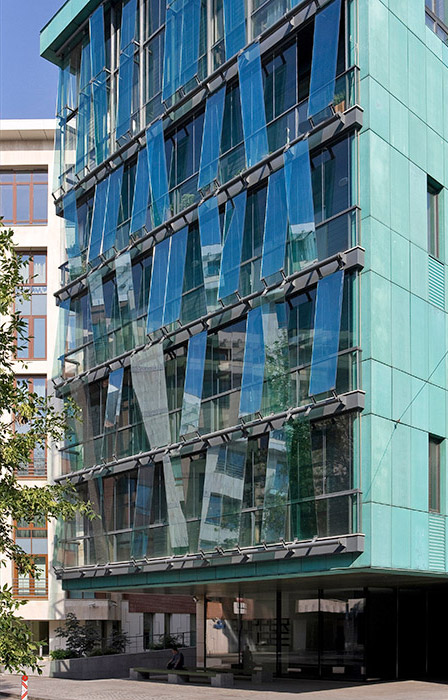
Ship House. 2, Bolshaya Tulskaya Str. // Built in 1981 by the USSR Ministry of Atomic Industry, this is one of the few buildings in Moscow that can withstand a nuclear explosion. The foreman who oversaw its construction spent his entire life building only nuclear reactors, which left its mark on this house. To prevent it from “folding up” in the event of an explosion, there are no 90° angles in this seismically stable house — only 87° or 93°; the thickness of the glass panes is a unique 0.23 inches. It is called the “Ship” because of its huge size (1312 feet long, 164 feet high) and encircling balconies that resemble decks.
Elena Pochetova
Egg House. 1/11 Mashkova Str. // Moscow has always been famous for its crankiness and sweeping gestures, including architecture. One of the most striking and outrageous examples is the “Egg House”. Originally planned to be built in Bethlehem as a maternity ward, it was eventually put up in Moscow. Outwardly, it resembles a giant copy of a Fabergé egg. It is the only such house in the world.
Lori / Legion Media
Arseny Morozov Mansion (Reception House of the Russian Government), 16 Vozdvizhenka // This house was built in 1899 by order of young millionaire, dandy, and merchant family heir Arseny Morozov on a plot of land given to him by his mother on his 25th birthday. Even at the construction stage, the house, which was executed in a Moorish style unprecedented for Moscow, became the butt of ridicule and criticism. When it was finished, legend has it that his vexed mother’s words were: “Only I used to know that you’re a fool, now the whole of Moscow will know!”
Lori / Legion Media
Nautilus Trade Center, 25 Nikolskaya Str. // In the early 2000s, this mall became Moscow's new “Morozov Mansion” — lambasted by everyone for its vulgarity. The pretentious postmodern architecture seems to jut out of an edifice on one of Moscow’s oldest streets, but the place once sited the Vladimir Gates of the Kitai-Gorod Wall and the Chapel of St. Panteleimon — buildings that were also rich in gaudy architectural details. Furthermore, the region was always a hotbed of commerce, for which reason a shopping center is quite apropos. Who knows, maybe in future Nautilus — like Morozov’s house before it — will become a feature of classic Moscow architecture.
Lori / Legion Media
Copper House, 3 Butikovsky Lane. // Built within the “Golden Mile,” historically the most expensive area of Moscow, this three-block residential house of 20 apartments was admitted to the Moscow Museum of Architecture’s collection of finest buildings in 2003-2004. It is faced with prepatinated copper plates and is one of the most expensive blocks in Moscow.
Lori / Legion Media
Stolnik House, 5 Maly Levshinskiy Lane. // Stolnik stands among the old lanes of Arbat Street, still home to places where Pushkin once resided. This residential house made of glass and metal literally explodes the architectural environment. However, there is something vaguely classical about it, namely the three-part symmetric layout and “Corinthian column” motif.
Lori / Legion Media
Kitezh Business Center, 3-7 Kievskaya Str. // This business center resembles the Titanic. The unique shape is the result of the complex internal structure — many of the shafts and stairwells are inclined and curved. Such a project would be beyond many architects, but Dmitry Bush has been building stadiums and ice rinks in Russia for many years.
Lori / Legion Media
Melnikov House, 10 Krivoarbatsky Lane. // This single-unit house, built by the great Soviet avant-garde architect Konstantin Melnikov for his family, is today an architectural monument of national significance. It is unique for its shape — two intersecting cylinders each truncated by a third of its radius — and its hexagonal window apertures encircling the entire circumference of the building. There are 60 windows in total, while the apertures in the walls number more than 130 — all stuffed with brick and construction debris (not a single wheelbarrow of waste was removed from the site!), but able to be unblocked to create a new window anywhere in the walls. Melnikov placed such windows in all the walls so that his hand never overshadowed a blueprint in his studio. The internal area of the house is very modest — a mere 2691 ft². Melnikov’s descendants live here to this day.
Lori / Legion Media
Department for Brain Research of the Neurology Center under the Russian Academy of Sciences, 5-7 Obukha Lane. // Built in 1914 in the era of art nouveau, this building is a former Evangelical hospital for the poor. In Soviet times, it housed the Brain Institute, which primarily studied the brains of prominent (and deceased) state and public figures: Lenin, Mayakovsky, Landau, Sakharov, Michurin, Gorky, and others. Of all the houses in Moscow, this building most resembles a gloomy castle from a gothic novel or vampire legend, especially in overcast weather.
Lori / Legion MediaAll rights reserved by Rossiyskaya Gazeta.
Subscribe
to our newsletter!
Get the week's best stories straight to your inbox